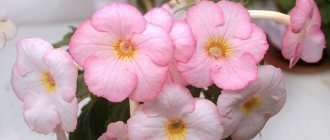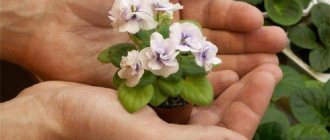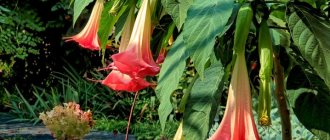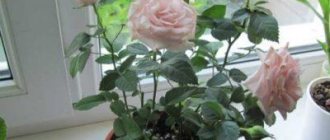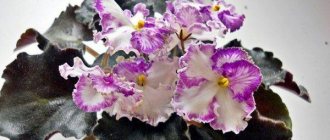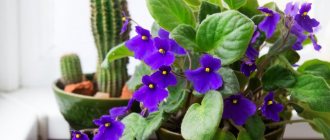What mini violets look like
The botanical features of this subshrub are the same as those of all members of the family. Leaves are alternate or in a basal rosette. The surface is fleecy. Flowering is characterized by a rich color palette. Petals can be plain or variegated. There are cup-shaped buds, double buds and more. Each has 5 petals. Sepals are often present. Belongs to self-pollinating species. In place of the buds, a seed box is formed.
Violet mini Le blue buttercup
All varieties are divided into three groups:
- micromini – flower diameter does not exceed 6 mm;
- mini – flowers reach 1.5 cm;
- semi-mini – diameter up to 2 cm.
The symmetrical, fan-shaped cap of greenery with inflorescences, which can be observed for 5-7 months a year if the plants are properly cared for, is whimsical. This flower will look great next to succulents and mini-trees, indoor herbaceous flowers and vines.
Varieties of miniature violets
Miniature species of violets have several groups. Despite their differences, they all have an important feature - the presence of “leaf girls”. These are rounded leaves with scalloped edges. Another sign is a lightened area of the central vein, which is located at the base of the plate.
Semi-miniature
Violets, which are classified as semi-miniature, have a flower diameter of up to 200 mm. One of the representatives is Adirondack Moon. The inflorescences are white, densely double. In the center of each flower there is a yellow core. The leaf blades are oval, medium in size, green in color with white speckles.
Aca's Happy Star is a beautiful compact flower with neat oval leaves. The shape resembles a dark pink star. From a bright yellow core emerge thin purple rays in the middle of each petal.
Aca's Johnny Redcoats is a plant with densely double flowers of a rich dark pink hue. Leaf blades are bright green. The edges are painted pink.
Miniature
A rosette of miniature varieties of violets up to 150 mm in diameter. Representatives include:
- Alan's Blue Star - a flower with large blue buds with a slight pink dusting and a thin rim along the edges of each petal;
- Gleeful Elf is a small rosette with bright green leaves and soft blue flowers in the shape of small balls;
- Bahamian Sunset - double flowers of rich lilac color with a neat white border along the edge of each petal.
Microminiature
Microminiature Saintpaulias include specimens with a rosette diameter of up to 60 mm:
- Amoeba;
- Dainty Dynamo;
- Child's play;
- Rob's Twinkle Blue.
Microminiature violets are not yet so popular, but they are confidently winning the hearts of Saintpaulia lovers. Caring for these plants is quite simple, and flowering often occurs earlier than traditional sized violets.
Description of common varieties
How to feed violets for abundant flowering at home
The semi-mini violet Crimson Magic has burgundy-colored petals curled along the edge. Severity and tenderness are harmoniously combined in them.
The flower will give you a romantic mood. It will create a holiday by settling on the windowsill.
The white edging on the leaves of the mini violet variety Shirl's Red Sky will convince even a skeptic that this is the queen of indoor flowers. It is especially charming when the pink and lilac buds appear. But even when there are no inflorescences, it is not the season for bright colors, the bush looks original and attracts attention.
Each variety has its own special charm
Supporters of extravagance and non-standard solutions will like the miniature Saintpaulia Le - blue buttercup. It is unlike any other variety. The soft green buds gradually become bluish and lilac.
The semi-mini violet Le Scales also looks no less original. The blue flowers are gorgeous. The foliage is heterogeneously colored and attracts attention. Coral and platinum inclusions create a pleasant contrast with the dark green background.
The mini violet called N-Thumbelina has pink-orange flowers. Their shade is close to neon. The edges are outlined with a thin crimson rim. A special feature of the Irish Flirt variety is the waviness of the petals. Mac's Flamboyant Flame has them, on the contrary, pointed. In the winter rose they are located in such a way that this mini violet can really be confused with a rose.
These are just a few popular varieties. There are many of them. Breeders are enthusiastically conducting more and more daring experiments in order to surprise and amaze flower growers and violet lovers.
Briefly about the history of appearance
Today, violets are found in Siberia, the Caucasus, and Crimea. They grow in Europe, Asia, North and South America. You can meet them in the forest and in the mountains. The mini violet was bred by breeders in the 50s of the 20th century; it retains connections with wild species, but at the same time is not similar to them.
Features of caring for mini violets at home
Bokarneya: home care and popular types
The microclimate of the room in which purchased indoor flowers find themselves sometimes does not meet their requirements, so the plants wither. No matter what the owner does, the result is not comforting.
Important: having bought a mini violet, in the first few days of its stay in a new place, you need to adjust the lighting, air temperature, humidity level, follow the watering rules, and replace the soil if necessary.
It is advisable to prepare everything in advance. Miniature violets are plants with strong immunity. If the environment is not suitable for them, they will be able to actively grow for a while. Then they will begin to fade. The owner must care for the plant and pay close attention to its needs. Otherwise, unpleasant surprises cannot be avoided.
Temperature
The air temperature in the room in winter should be from +20 and above, and in summer, from +25 to +28. In this case, everything will be fine with mini Saintpaulias.
Lighting
The plant loves sunlight. Daylight hours should be 10-12 hours all year round. That is, it is advisable to use bio lamps.
Watering
Mini violets do not tolerate excess moisture in the soil. They react extremely negatively to too frequent watering, large amounts of water, or a pot without holes in the bottom. They should be watered twice a week, removing dried leaves and inflorescences, if any. It is advisable to pour water along the edges of the planting container, and not at the root.
Humidity
Air humidity is of great importance for violets. But creating the right conditions is easy. If there is excessive humidity, you should ventilate the room, and if there is insufficient humidity, place a container of water next to the flower. The flower itself will help determine that the air humidity is not suitable. In the first case, the leaves begin to wither faster and become smaller over time. In the second, on the contrary, they grow too big. Disproportion makes a negative impression; the bush is sloppy and lacks symmetry.
Priming
Sand is useful for creating a drainage layer at the bottom of a flower pot. Chernozem should be used as soil. It should be loose: the root system of the flower will not rot, and watering and fertilizing will give a more pronounced effect. To make the soil “airy” and light, sand or sawdust or tree bark are most often used.
Need light, nutritious soil
This is a good option, but experts recommend choosing more specific types of baking powder:
- perlite;
- vermiculite;
- sphagnum moss.
They will enrich the soil with mini minerals important for the growth and development of Saintpaulia. The risk of infection by wood beetles and other pests is eliminated.
Feeding
Classic mineral mixtures for indoor plants are universal and are also suitable for this flower. They help you save money while maintaining your home garden in perfect condition.
Memo to a newbie
A variety of flowers, externally and not only similar to violets
Uzambara (Uzumbar) violet is a plant of the Gesneriaceae family, growing in the natural environment of tropical and subtropical regions of Asia, Africa, Eastern Australia, South America and the Indian Ocean islands.
Saintpaulia is a plant named after the Saint-Paul father and son, who brought a plant unknown to Europeans from the Uzambara district (modern Tanzania) in the 19th century, presented for the first time at the international flower exhibition in Ghent in 1893.
Indoor violet has been one of the most popular plants in indoor floriculture since 1927. By 1949, more than 100 varieties had been bred, and today their number exceeds several thousand.
Rooting
- possibly in water, in substrate, moss.
Priming
- purchased soil or a mixture of leaf, coniferous, turf and peat soil in a ratio of 3:1:2:1 with the addition of raising agents (perlite, vermiculite, river sand, crushed sphagnum moss.
Lighting - it is best to place flower pots on western or eastern windows. To ensure that the plant is evenly illuminated from all sides, the pots are periodically rotated. In winter, when daylight hours decrease, you can use artificial lighting - fluorescent lamps.
Caring is a real art and serious painstaking work at the same time, including watering, fertilizing, and creating a favorable humid climate. Water Saintpaulias as the soil dries. The soil must be moistened regularly, but excess moisture should not stagnate in the roots. When watering, you must ensure that water does not get on the leaves. You cannot water the Uzambara violet with cold water. Fertilizing is done with complex mineral fertilizer once every two weeks. Saintpaulia reacts negatively to a lack of nitrogen in the soil. Optimal air humidity is approximately 50%, temperature is 20-22 ° C, without sudden fluctuations and drafts. The leaves of the plant should not touch the window glass. Removal of faded flowers and damaged leaves is carried out regularly.
Reproduction - planting a leaf cutting, part of a leaf, or a daughter rosette. The most popular method is rooting leaf cuttings. The formation of roots and the development of children lasts 4-8 weeks.
Pests are one of the gardener's problems. There are many different types of pests and it is very difficult to classify them. Among Saintpaulia pests, several groups can be distinguished: mites (spider mites, flat mites, transparent mites, etc.), insects (aphids, thrips, springtails, poduras, scale insects, whiteflies, scale insects, etc.), worms (nematodes).
Diseases - distinguish between infectious (gray rot, powdery mildew) and non-infectious diseases (rotting of the stem and root, wilting of the lower leaves, yellowing, leaf spotting, incomplete opening and premature drying, falling of flowers) of plants. The causative agents of infectious diseases are bacteria, fungi, and viruses. To prevent infectious diseases, you should strictly observe the regimes of watering, temperature, humidity, and lighting. Non-communicable diseases usually arise due to poor agricultural practices. They may appear in one instance and not spread to others.
When and how does it bloom
How to water violets - rules and features of watering
The flowering period does not depend on the time of year. Saintpaulia mini is a completely domesticated flower. The duration of flowering is determined by the variety. In most cases this is 4-5 months. If the ovaries do not form, you should be more careful about care. Perhaps there is not enough light or nutrients.
Important : During the flowering period, Saintpaulia should be watered more often, with a large amount of liquid. The need for nutrients and moisture increases.
Transplanting mini-violets after purchase
It is recommended to replant some flowers every few years. In the case of mini violets, home care involves annual replanting. Thanks to this, it will be protected from salts and mineralization accumulating in the soil. For the first time, it is advisable to perform the procedure immediately after purchase in order to awaken defensive reactions and trigger the adaptation mechanism.
It is recommended to replant the flower immediately after purchase.
This is also an excellent opportunity to replace the planting container with a decorative one. If you place the violet close to the edges of the pot when planting, a green island will appear on the windowsill. When planted deep, it will evoke associations with an exquisite bouquet.
The dimensions of the new flower pot should be the same as the container in which the violet was sold. The exception is those cases when it is discovered that the root system is more developed and no soil supply is provided. In such a situation, you need to use a larger pot.
Reproduction
Leaf cuttings are ideal for propagating violets. It is necessary to cut the leaf along with the petiole from the mother plant along the lower edge with a razor blade and spray it to eliminate the risk of rot. Then bury it about 1 cm in a mixture of peat and sand (without fertilizers). The substrate must be moistened with warm rainwater.
How to care for a violet that has just been planted:
- wrap the pot in a clear plastic bag to create a sultry climate;
- place in a bright place, but not in the sun. Temperature – from 20 to 25° Celsius;
- Open occasionally to ventilate and prevent mold from forming.
Under ideal conditions, offspring appear next to the cutting after 4-6 weeks. The sprouts are 2-3 cm high, separated from the mother plant and can be transplanted into 9 cm diameter pots as adults. The time from appearance to transplantation is about 3 months.
Possible problems in growing mini violets at home
Not only violation of the rules of care can lead to problems. If the cuttings rot, it is necessary to cut off the damaged leaves and reduce the frequency of watering. But when brown spots appear on the leaf blades or when young shoots wither, you need to save the flower from mites.
External signs of problems
A well-groomed violet looks elegant. The foliage is symmetrical. Flowering is stable and colorful. Ungroomed – has a less attractive appearance. If attacked by a fungus or mite, her future is in question. There may be two or three leaves left in the end, then they too will fall off.
Diseases
Powdery mildew can cause damage to the flower. The foliage becomes covered with a white coating and becomes thinner. This is a sure sign of a growing fungal population. After some time, dried areas become noticeable. It is advisable not to delay treatment until later; cut off damaged leaves immediately.
One of the signs of flower disease is dark-colored spots on the leaves.
Only in rare cases is this measure sufficient and the violet recovers on its own. Most often, lesions appear in other areas within a day or two. Purchasing a fungicidal drug and treating the flower and soil with a specialized product will change the situation.
Important : every violet leaf is valuable. Reproduction occurs by seed or by rooting leaves.
Pests
Ticks often live on indoor plants, violets in particular. The structural features of the mini violet bush and leaf plate are attractive to them. Signs of their presence are:
- darkened, red or brown spots on the leaves outside and inside;
- thin cobweb;
- deformation of leaves - tubercles, compactions against the background of thinned sectors, unnatural surface roughness.
A unique indoor flower, the miniature violet is indispensable when creating an atmosphere of comfort and romance in a room. Her neat bush reminds of restraint and rules. The soft edge of the foliage refracts the light, creating a barely noticeable glow. The bright colors of the petals improve your mood.
